As always, I like better to address the bad before getting to the good. Despite my cold, stern demeanour, I love giving good news last to lift the spirits. However, having analysed some of the things that made Twin Peaks’ second season pale in comparison to the first, I find myself at a loss. How do I go about this? How do I start addressing the things that made Season 2 worth it? Though it may compromise my journalistic integrity, I do love praising the things I like, unabashedly so. Even if we talked about the bad already, it’s best to maintain some critical distance. That’s the most important thing a certain professor taught me in Uni, aside from how to talk to pretty girls.
Thus, I find it effective to choose simplicity. Here is a quote by Neil Gaiman from Alexander O. Phillipe’s documentary, The People vs. George Lucas. I feel it conveys the point. “Fans know exactly what they want. Fans want more of the last thing they read and they liked. That’s what fans want. They liked that thing you did, they would want another one of those, please.”
David Lynch and Mark Frost had made something so unique and engaging with those eight first episodes. The only real way to go about it would be to keep doing what they did on the following season. And that’s really what made the lovelier (though smaller) half of Twin Peaks’ second season a beautiful thing. Deep character development, unconventional filming techniques, technical and thematic contrasts, and some quirks of their own. All of this we can find back in the first season. But this time around, there is something else at work: ambition – a deeper mystery than Laura Palmer’s murder.

We handled the introductions and ceremonies last week. As last time, this is an assessment based on subjectivity. Also, astoundingly MAJOR SPOILERS lay ahead. Now that we’ve gotten all disclaimers out of the way, let’s just get to it, by levels.
Bullet Wounds and Glasses of Milk
Nothing in life is as mundane as guns and dairy, unless you’re lactose intolerant, of course. In Twin Peaks, however, both are indeed the furthest from mundane. In a formerly idyllic town (almost Canada, really), violence was quite unheard of. And nobody in this town spoils their coffee with cream or milk. Except for an occasional fish in the percolator, it’s all pretty standard. We start Season 2 with both elements functioning together in an amusing, and rather brilliant fashion. Coming from past season’s cliffhanger, Agent Cooper lies on his hotel room’s floor after being shot. He isn’t dead, but doesn’t look far from it. He could possibly do with a hand.
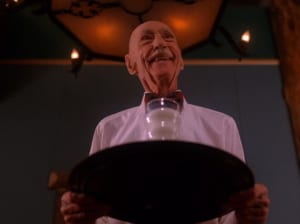
Enter the ultimate Room Service man. We won’t get into who this character is just yet. But it will suffice to say that, utterly unfazed by our protagonist’s predicament, his greatest concern is that the glass of milk the Agent ordered won’t get cold. Room service is no trifling matter.
The relevance of this scene lies elsewhere. However, this is indicative of the very unique Twin Peaks’ narrative flavour. In face of direness and gravity, there is always room for some quirks and chuckles. And the wonder is that neither tone negates the other. This series is a world where the eccentricity works parallel to the tragic. Occasionally, both combine into a greater effect. Case in point, Leland Palmer’s compulsive dancing while weeping for her daughter. You just didn’t know how to digest the scene, yet you couldn’t look away.
It’s safe to say that this season took this duality and ran with it, for a while. Although it spawned a few lukewarm sideplots such as Ben Horne’s redemption through wacky insanity, the effect was memorable when well executed. Plainly put, the series didn’t become inebriated in the gloom of its core narrative. If there was room for laughs, there was also room for cold sweat, and we had no shortage of it. If there was any doubt of it, the realm of dreams is full of nightmare fuel.

The proportion of comedy and drama is by no means equal. We already saw how wasteful several of the subplots were. However, it bears mention that when well executed, the comedic subplots were a serviceable counterpart to the looming conflict. We had lovable doofus Andy and a pretentious Dick vying for Lucy’s affections and baby. When reformed criminal and husband to Norma’s mother, Ernie Niles came by, proved a fairly amusing and loveable character. We saw the sheer absurdity of virtually every male in town fawning over local temptress Lana. Even former baddie Catherine Martell masquerading as a Japanese businessman delivers some much-needed levity. And basically every scene featuring Gordon Cole, played by David Lynch himself.
Thus, on the other hand we get the graver facet, the driving force and the very reason we’re here. Sure, we still have Laura Palmer’s murder in our heads. But a new wave of adversity came upon our shores following the murder’s solving. It all starts with Cooper being incriminated for drug possession. Nobody buys it, either in and out-of-universe. Nonetheless, this serves as a preface towards a series of vendettas against our hero. Two characters rise from the aftermath of recent and faraway past as villains. On one hand, Jean Renault will seek vengeance for the fate that befell his brothers. His scheme involves, among other things, Audrey’s captivity in a figurative den of wolves. An equally sinister but less subtle antagonist comes in the form of Windom Earle. And his methods are best reserved for further ahead.
Despite its obvious shortcomings, Season 2 had its lovely share of intrigue and humour. But these things alone can only go so far. Sometimes, we need a few charming personages to steal our breaths, or to capture our fascination.
Memorable Personae: She, She, and He
Most characters in the series are noteworthy for one or several reasons. Whether by their role in Laura Palmer’s life or their own quirks, there is a lot to be said. However, three characters in particular became far more than just noteworthy. Not only did they shine through their performance but they carried special significance on a grander scope.
An uncanny resemblance: Maddy Ferguson
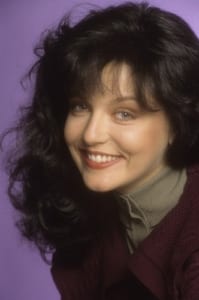
The time when Twin Peaks truly first captivated me was when I was in Uni. Incidentally at the time, I was also fascinated by French actor Marie-France Pisier. Thus, when Sheryl Lee showed up portraying Madeleine Ferguson, I saw a definite resemblance there. Although Maddy lacked her cousin’s mystique, she always struck me as a graceful, elegant character. The more we approached Laura after her death, the less approachable she seemed. But Maddy, she was earthly and charming; all in all, an easy-to-love character on her own. However, her striking resemblance to Laura drew her in towards the heart of the conflict, in spite of herself. At first, she had come to Twin Peaks to attend Laura’s funeral, as they were close. Eventually, she teamed up with Donna and James to do some investigation of their own.
Come Season 2, her role doesn’t precisely change much, but it now comes with a twist. Her interactions with James become a little more intimate-looking, which Donna misinterprets as something personal. Donna is not in the wrong though, as James does develop feelings for Maddy. This and Maddy’s mental link with Laura puts some strain on Miss Ferguson. Her own persona becomes blurred in favour of Laura’s phantasm in the eyes and mind of the townsfolk. This sounds pretty aggravating in itself, but it takes a whole more ominous tone concerning Leland Palmer. Maddy becomes very perceptive about the changes in her uncle’s demeanour and hair colour. In fact, this could be foreshadowing her ultimate fate after announcing that she’d go back home soon. More on that later.
Throughout it all, she fitted flawlessly in a narrative that can essentially be seen as the perennial fight between good and evil. Opposite to Laura’s erratic and destructive behaviour, we had innocent Maddy reminding us there’s good in the world. It suffices to say that Season 2 painted her beautifully as a loveable, yet tragic character.
A heroic representation: Denise Bryson

It’s always a joy to have David Duchovny around. Expectations are high when you know he’ll be in something. Those expectations were met with a significant twist for the time. In the wake of FBI Special Agent Dale Cooper being framed for possession, they expect DEA Agent Dennis Bryson to lend a hand. Little does Coop know, Bryson was no longer quite the same person he had known. During an undercover drug bust operation, Dennis found that he felt more comfortable dressing as a woman. This was just the first step in a longer transformation. By the time we meet Denise, she is at the threshold of therapy involving hormones and electrolytes. Thus, we get a rather ground-breaking trans character that’s actually plausibly handled.
Truly, she was a vital ally throughout Cooper’s suspension from the FBI. In the climax of Jean Renault’s plot, she supplied the means for the protagonist to survive and take down the baddie. Even before that, during a staged drug buy, she took on the guise of a male so as not to compromise the mission. Mind you, she did this by the time when dressing and performing as a male were no longer natural to her. If her partner had claiming the guise of a woman was consummate professionalism, dressing male is most certainly so. Thus, Denise functioned well as an ally during a situation where our heroes needed outside intervention. She was audacious, competent, and very patient. But her character shines also on another level.
Cooper’s arrival broke the mould in terms on investigation and deduction methods. His mode of discourse was also unorthodox and basically made you think everything was possible. Bryson’s arrival shocked even he who shocked them all. These reactions paint the characters as products of a tradition in terms of gender and identity. Since this tradition was long and largely univocal, the initial shock appears almost expected. However, through the show’s writing, the characters are still mature enough to see past the impression. They then see Denise, not as an outsider, but by her personal qualities. Therefore, the taboo and the monolith of binary gender cracks a bit at least, which is considerable during the early nineties.
A friend on the other side: The Giant
And now we come to a massive fan favourite, and I mean that both literally and figuratively. He is a dweller of the other side. He’s so very tall. Above all, he’s an indicator that there’s much more to Laura Palmer’s murder than meets the eye. He’s also very, very tall, so the indication is not subtle by any means. The character is so memorable that we owe him all parodies on the cryptic feel of the show. Safe to say, his words really are cryptic and his appearances are scarce. And he always shows up, seemingly from thin air. Soft spoken, though imposing and mystifying, his first appearance will always be remembered through three sentences. Lying on the floor after being shot, the Giant appeared to tell him three things that would prove true in the future.
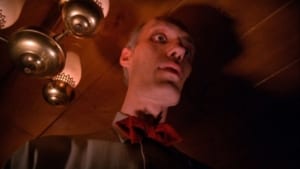
“There is a man in a smiling bag. The owls are not what they seem. Without chemicals, he points.” These three things indeed proved true, confirming what a viewer already suspects. This character is also a resident from that peculiar red room where we met the Man from Another Place. As such, he possesses a possible understanding beyond what the characters can comprehend in the physical world. He would then appear a second time to tell the Agent something he had forgotten to the first time. A “third man” had made an appearance; he is talking about a third suspect. Neither Leo nor Jacques had murdered Laura, but a third man who was not a suspect. The Giant’s words serve as clues for the ongoing investigation.
The efforts of Cooper and the Bookhouse Boys were valiant, but they failed to find the culprit until it was too late. When a second victim appears, The Giant shows up anew to declare that “it is happening again”. In the context of the series, we need hear no more. In the same context we can see him as somewhat of an ally amidst the uncertainty. Unlike the Man from Another Place, his intent seems to be considerably less ambiguous. And whereas the small man caused bewilderment in his cryptic discourse, the Giant is somewhat soothing. The aftertaste of his appearances was such that one could easily endure the dry spell of the mid-season to see him again. We did see him one last time on the finale, when the truth was before us. Yet it was too late to go back. What do I mean by that?
The Horror, the Horror: The truth behind the mystery
When reading Joseph Conrad’s Heart of Darkness, one shudders to think of Kurtz. His realisation on the effects of Western Imperialism on Africa set him on a path towards madness. Looking back on it, there’s nothing to do but to acknowledge the terrible deeds and the inflicted damage. Let’s transition from the collective to the individual, and we’ll also have nothing to do but quote Kurtz. We know from last week’s piece that Lynch and Frost never did intend to solve the mystery. Alas, they did on the seventh episode of the second season, “Lonely Souls”. It is, in my opinion, the highest point of the entire series. It is both brilliant and horrifying, and the truth behind the deed is even worse. At this stage, the quirks and levity are gone, my friends.

After Cooper’s swift recovery from the gunshot, the investigation goes on. The combined effort of James, Donna and Maddy proves vital as they uncover something previously unknown. Laura had kept a secret diary, which she gave to agoraphobic horticulturist Harold Smith. Donna takes on the Meals on Wheels route Laura used to handle in order to obtain the diary. Since Laura trusted him with it, he was unwilling to turn it over to the police. So, Donna had to resort to guile and lying to take it. The disappointment and heartbreak in being cheated was such that Harold suffered a meltdown, and hung himself. The police found the diary on him soon after. It was a terrible price to pay for a piece of an equally terrible truth.
The diary revealed that BOB, a friend of her father’s, had repeatedly raped her a child. For this reason, she took to drug usage to cope with the trauma. This name is compound with other mentions from Phillip Gerard, the One-Armed shoe salesman. Having shown such a troubled reaction before the sketch of the man Sarah Palmer saw, he became a person of interest. Without the aid of his medications, his inhabiting spirit, MIKE, started speaking. He ominously revealed that BOB and he were alike, two spirits that feast on suffering. No longer wanting to do despicable deeds, MIKE sought redemption and cut off his own arm. He discloses that BOB has been around for about forty years, and that he was in a large house made of wood.
From this statement, Ben Horne became the prime suspect. This was a mistaken conclusion, as the killer lay elsewhere, ready to strike again. The buildup to the following moment is powerful. The sensation of discovery is there, albeit flawed. But a pervading feeling of wrongness plagues the air.
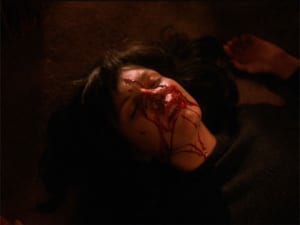
Then, we can only dread the worst when the scene transitions to the Palmer household. Maddy is there, and so is Leland. One gaze into the mirror and his face shifts into that of the long-haired man. Leland Palmer is the killer, Leland Palmer is BOB. So now ensues one of the most disturbing moments of the series. I personally can think of very few things that can match it. Maddy’s murder is long-drawn and its leadup is full of depravity. The killer switches appearances throughout, from lustful BOB to tearfully unwilling Leland. Finally slamming her head on a painting, BOB brings the same end he brought Leland’s daughter. This is both a reprisal of Laura’s suffering and a devastating crime of its own. I bet this scene broke a few hearts. I know it broke mine. But it’s not over.
Without a doubt, this episode has David Lynch’s directorial brand all over it. A leisurely evening at the Roadhouse prefaces Maddy’s murder. The band and Julee Cruise play on stage and everything’s swell. Then, the Giant appears on stage as time appears to have frozen. Cooper and the Log Lady seem the only ones aware to receive the message. “It is happening again.” And once it did, time resumes its pace, but the world is now a different place. The Room Service man approaches Coop’s table and he says the only words we have ears for. “I am so sorry,” revealing himself as a host to the Giant and making his aid and compassion twofold. In their respective spots, Donna and Bobby know instinctively that something terrible has happened. The sadness contained in the scene effectively brings this arc to a close.
Under the Sycamore Trees
Leland is, of course, apprehended. However, we now find that we were only scratching the surface all along. BOB is in control of Leland, and now that he’ll be imprisoned, he’s useless to him. So, the spirit controls his body into killing Leland by smashing his head against the door. With dying breaths, Leland expressed infinite guilt over what he did to his daughter. He couldn’t control BOB, who possessed him since Leland was a child. Thus, he raped and killed, and could not do a thing to stop it. And now, BOB is on the loose again, and he will kill again. It’s a frightening declaration to keep the series going. However, the dry mid-season spell followed soon after, and the series lost momentum.
Concerning this new arc, the main conflict was to find and stop BOB before he inhabited a new host. The course of action is to gain information on his nature and that of the place he comes from. It’s so that we got two characters to present two places of vital importance. We spoke already of Windom Earle and his vendetta against Cooper. However, what we didn’t say then is that his purpose was not actually revenge. In fact, it was all a scheme to gain access to a place called “The Black Lodge”. It sounds foreboding enough. On the other hand, Major Garland Briggs reached major prominence (hah) by alluding to a similar place. “The White Lodge” was a place that we can understand as diametrically opposite to the former. Alas, the information regarding this place was actually more obscure.
Nonetheless, the sense of urgency heightened as we reached the final episode. All the main pieces were in their appropriate positions. Earle had forcefully obtained information on the Black Lodge from Major Briggs, a lot of classified stuff there. He also had captured Annie Blackburn, whom Cooper was in love with in order to lure him along. On his part, Dale Cooper had information from the Log Lady, who was aware of the nature of these metaphysical realms. So, the final pursuit began, leading to Glastonbury Grove, the entrance to the Black Lodge. On this place surrounded by sycamore trees we enter a place we had only visited in dreams. The waiting room, surrounded by red curtains and zigzagging black and white on the ground.
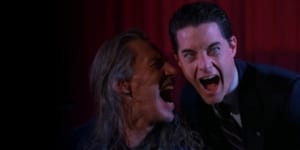
At no other point do we find ourselves in such an oppressive place. This is a place where the laws of physics have no meaning. Here, we find the Man from Another Place, the Giant, and a variety of doppelgängers to people alive and dead. It’s really quite unsettling, but also fascinating by it. One of the ways Twin Peaks has influenced a generation of creators is through eccentricity and weirdness. The other is through ambience that constantly inspires doubt. This is achieved through several ways; doppelgangers, broken speech, and utter unpredictability. The motifs come flooding back in, subverting the duality we know from Lynch’s work. There is a strong hinting that both Lodges are really one and the same.
All in all, this location gives off the impression that you can never escape it. Nonetheless, the chase goes on, further in through curtained hallways. Eventually, Cooper reaches Windom, apparently having walked into his trap. He starts bargaining for Annie’s life. Then, when it all seems lost, BOB shows up to claim Windom’s soul. The mini boss is down and the Big Bad is before us. A doppelganger of Cooper shows up and a dire race outside of the Lodge begins. Light and dark flicker in tension, as the dynamic boils down to the prevailing of one side. The following day we see Cooper lying in bed, with Dr Hayward and Truman looking concerned over him. From the very moment he speaks, we know something is wrong.
He gets up to go brush his teeth in the bathroom. Truman and the good Doctor aren’t any wiser. Yet we soon find out that it wasn’t OUR Special Agent who made it out there. There is nothing of the Coop we know and love in that face and body. One look in the mirror, and we get BOB’s perverse grin. Two words, repeated over and over, maniacally add insult to injury. “How’s Annie? How’s Annie?”

A heart wanting
This is how Season 2 came to a close, with a cliffhanger that dwarfs Cooper getting shot. Although an extra scene was made to tease Season 3, the damage was too much. The audience had virtually given up on the series. Twin Peaks was cancelled. Let us bathe in the sensation of it all. The very fact that, without a continuation, the series had to end on such a hopeless, dreary note. To drive the feeling further, even the credits were different. Whereas we almost always had the homecoming picture of Laura Palmer, unnervingly gazing at us in all her constructed perfection, we now have a shot of a cup of black coffee – Dale Cooper’s favourite beverage. It’s almost as if to say that we had now lost him, as we had lost Laura.
In spite of the bitter note of the ending, nobody can really say it wasn’t a powerful ending. Beauty in art can be conveyed in many ways, including catastrophe. The execution of the circumstances that led to this finale efficient, to the say the least. Enough to make us not mind the filler, and enough to stay hoping that our Special Agent would someday escape the Black Lodge. As we know, the love for the series never went away. There were still too many questions unanswered. After all, we had seen what fear can do as a force. But we were still yet to know what love could do. It’s too great a gap to leave like that.
Much as how one craves coffee and donuts in the percolator, a fringe, though passionate fanbase ached for more. In spite of the stumbles, Lynch and Frost had delivered something more than the things we loved from Season 1. They may have never quite intended it to take on this form, but the momentum was too intense to stop.
Thus, one year later…


